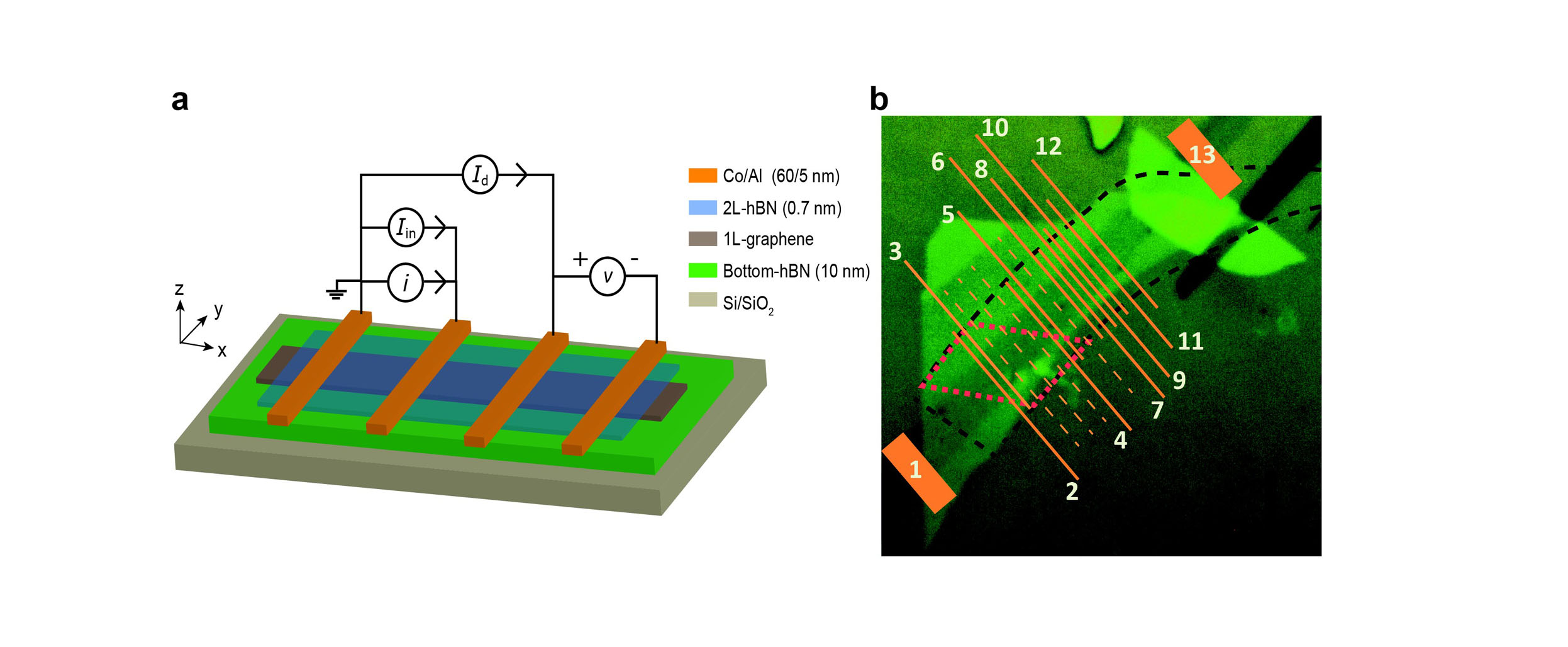Laagje van twee atomen dik brengt toepassing spintronica dichterbij
Natuurkundigen van de Rijksuniversiteit Groningen onder leiding van professor Bart van Wees zijn er in geslaagd om elektronenspin met ongeëvenaarde efficiëntie te injecteren in grafeen. Het spin signaal nam met een factor 100 toe, waardoor het groot genoeg is voor toepassingen zoals op spin gebaseerde transistoren of logische schakeling. Het onderzoek maakt deel uit van het Europese Graphene Flagship, een project waar de Europese Unie een miljard euro in investeert. De resultaten zijn op 15 augustus 2017 gepubliceerd in het tijdschrift Nature Communications.
‘Spin’ is een eigenschap van elektronen die twee waarden kan hebben: op of neer. Deze eigenschap is te gebruiken om informatie op te slaan, te verzenden of te bewerken. Maar het gebruik van spin is lastig. De spin gaat bijvoorbeeld in korte tijd verloren en tot nu toe was niemand er nog in geslaagd om meer dan een paar procent spin-polarisatie te krijgen. In ander woorden: het verschil tussen het aantal op en neer spins is altijd zeer klein.
Injectie en detectie
Het onderzoek in het lab van Van Wees richt zich vooral op het beter begrijpen van het gedrag van spin in verschillende materialen. Dat heeft al geleid tot wereldrecords in het transporteren van spin bij kamertemperatuur. De meest recente experimenten waren gericht op injectie en detectie van elektronenspin.
Bij spin injectie gaat het erom gepolariseerde spins in een schakeling te krijgen. Bij een normale elektronenstroom is het aantal op en neer spins gelijk. ‘Spin polarisatie krijg je door de elektronen eerst door een ferromagnetisch materiaal te sturen’, legt Van Wees uit. De magneet zorgt ervoor dat één type spins in overmaat aanwezig is.
De schakeling die bij deze experimenten is gebruikt bestaat uit een stapeling van laagjes van verschillend materiaal. Het hart hiervan is een laag grafeen, slechts één atoom dik. ‘Grafeen is een prima materiaal om spin in te transporteren, maar je kunt de spins er niet in manipuleren’, zegt Van Wees. Het grafeen ligt op een laag boornitride, dat weer op een silicium halfgeleider ligt. Bovenop het grafeen ligt nog een laag boornitride van een paar atomen dik die de elektronen in het grafeen afschermt van invloeden van buitenaf.
‘Om spins in het grafeen te injecteren moeten ze door de bovenste laag boornitride. Dat is een isolator, maar elektronen kunnen erdoor via een proces dat tunneling heet’, zegt Van Wees. In eerst instantie was de laag boornitride een atoom dik, maar dat bleek onvoldoende afscherming op te leveren. Een laag van drie atomen beschermde het grafeen voldoende en liet normale spin injectie toe. Maar bij een laag boornitride van twee atomen dik gebeurde er iets totaal onverwachts. ‘We zagen een hele sterke spin polarisatie, van wel 70 procent. Dat is tien keer de normale waarde.’

Toenemende polarisatie
Natuurkundigen nemen aan dat de polarisatie ontstaat wanneer de elektronen door de ferromagneet gaan. Maar in dat geval zou de polarisatie afhangen van de magneet en dus altijd even groot moeten zijn. In de schakeling van Van Wees nam de polarisatie echter toe met het voltage. ‘We hebben geen idee waarom dit zo is’, erkent Van Wees. Hij vond een vergelijkbare tienvoudige toename bij de detectie van spins in de schakeling. ‘Dus het totale signaal neemt met een factor 100 toe.’
Dit biedt allerlei mogelijkheden. ‘We kunnen spin in grafeen injecteren en gemakkelijk weer detecteren nadat het daarin een bepaalde afstand heeft afgelegd. Een mogelijk toepassing is als detector voor magneetvelden, want die beïnvloeden het spinsignaal.’ Een andere toepassing is het maken van een logische poort of spintransistor. Aangezien de experimenten allemaal plaatsvonden bij kamertemperatuur liggen die toepassingen binnen handbereik. ‘Maar’, waarschuwt Van Wees ‘het grafeen dat wij gebruiken is gemaakt via het afpellen van een laag grafiet met de plakbandmethode. Die methode is niet geschikt voor het maken van grote hoeveelheden grafeen.’ Er wordt wereldwijd wel gewerkt aan manieren om grafeen op industriële schaal te produceren.
Het onderzoek naar elektronenspin in grafeen is onderdeel van het tien jaar durende ‘Flagship project’ van de Europese Unie. Dit ging in 2013 van start en heeft een budget van een miljard euro. Van Wees is leider van het onderdeel ‘Spintronica’ binnen dit programma. Dit onderdeel heeft tot nu toe alle doelen behaalt en het lijkt erop dat het in ieder geval twee jaar door mag gaan. In die periode is samenwerking met partners uit de industrie om de labresultaten te vertalen naar toepassingen een belangrijk thema.
Van Wees slaagde er eerder al in om het transport van spin in grafeen te verbeteren en wist de richting van het transport te controleren. Nu heeft hij dus het signaal flink versterkt. ‘We moeten nu nog een beter begrip krijgen van de natuurkunde van spintransport en de werken aan technologie waarmee we deze spin-schakelingen kunnen inbouwen in grotere systemen. Maar we gaan ook denken aan totaal nieuwe toepassingen die nu mogelijk kunnen worden.’
Referentie: M. Gurram, S. Omar & B.J. van Wees: Bias induced up to 100% spin-injection and detection polarizations in ferromagnet/bilayerhBN/graphene/hBN heterostructures. Nature Communications, DOI 10.1038/s41467-017-00317-w
Meer nieuws
-
19 december 2025
Mariano Méndez ontvangt Argentijnse RAÍCES-prijs
-
18 december 2025
Waarom innoveren, en voor wie?
-
17 december 2025
Ben Feringa wint Feynmanprijs
